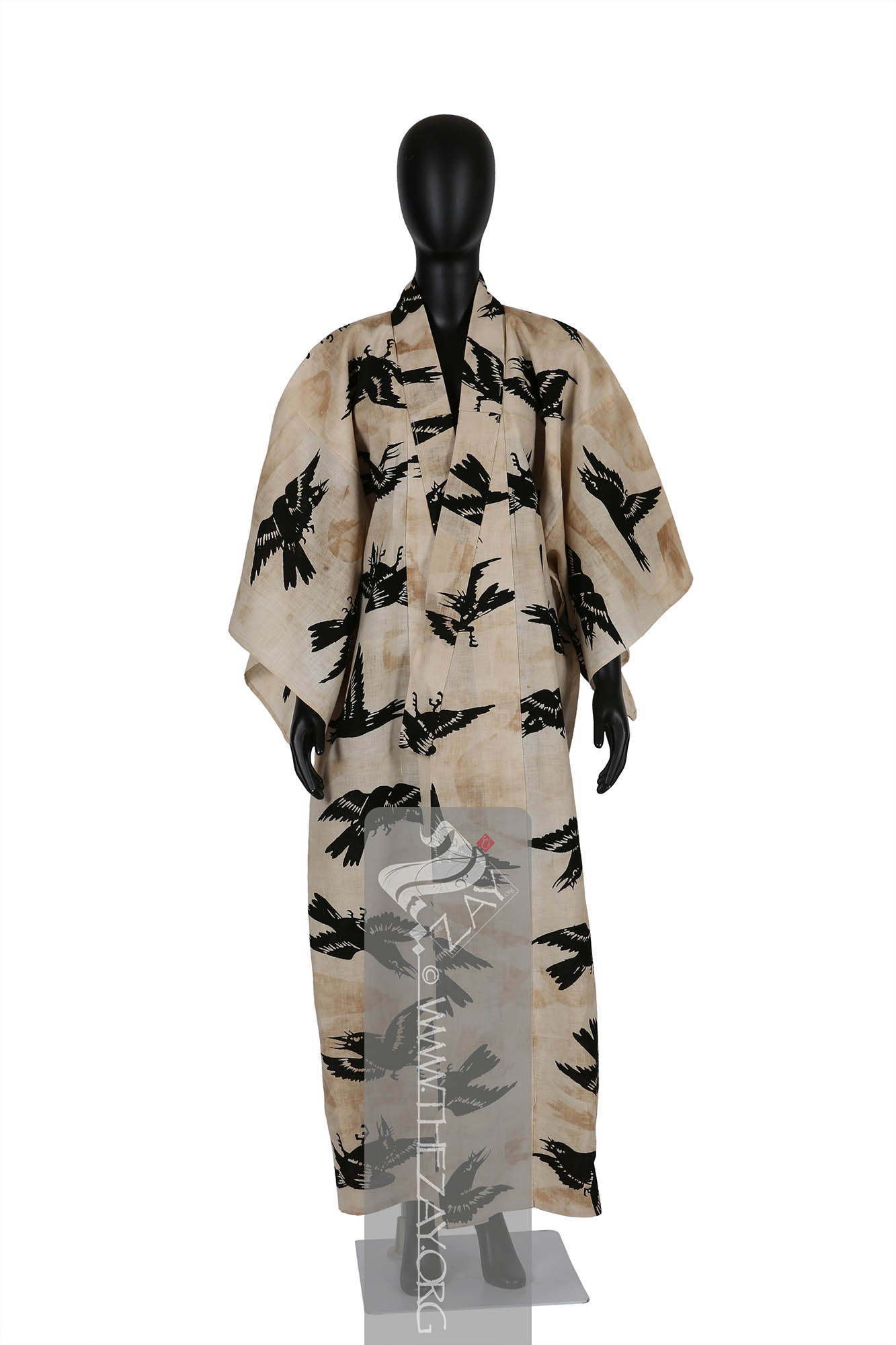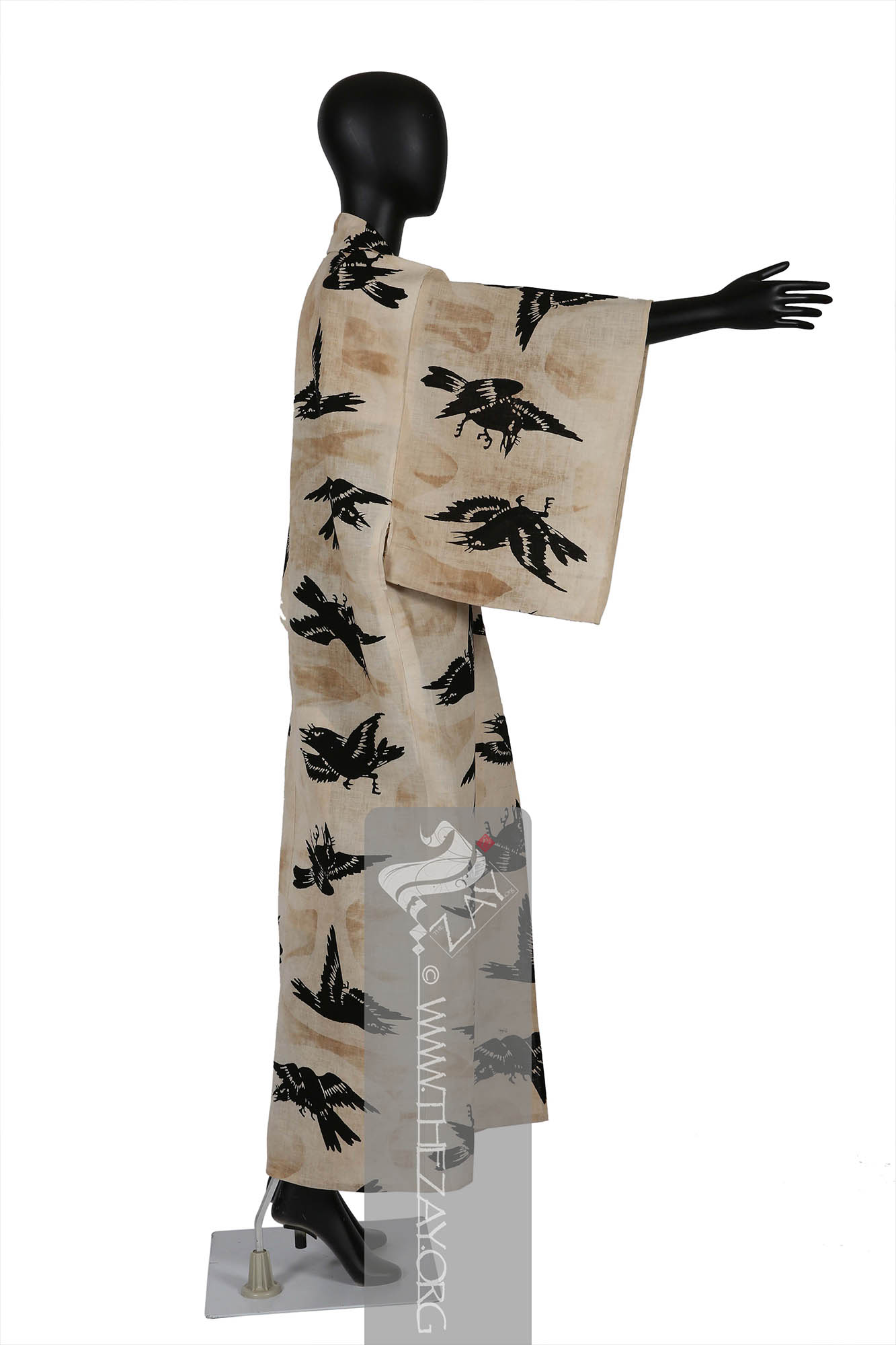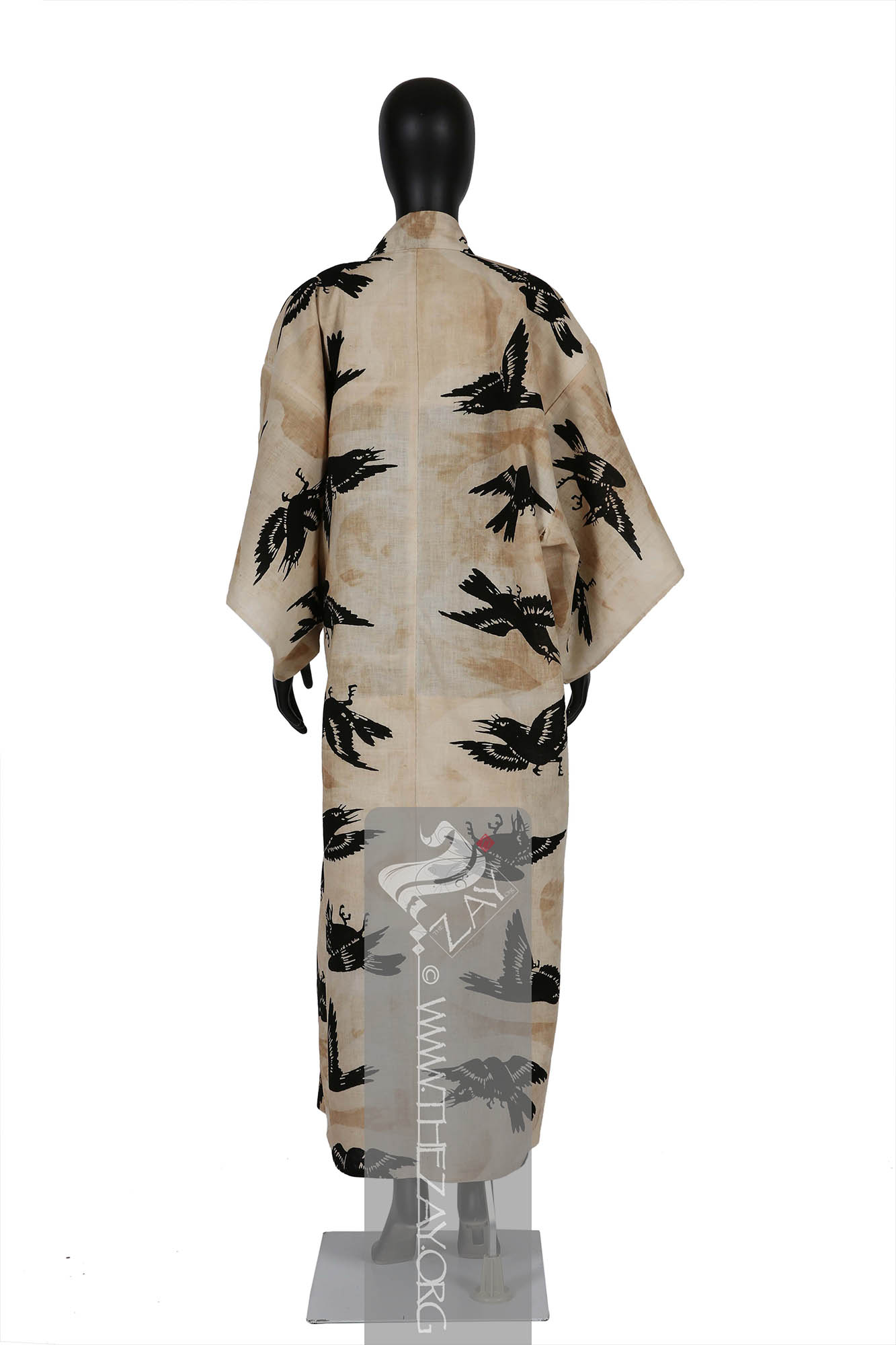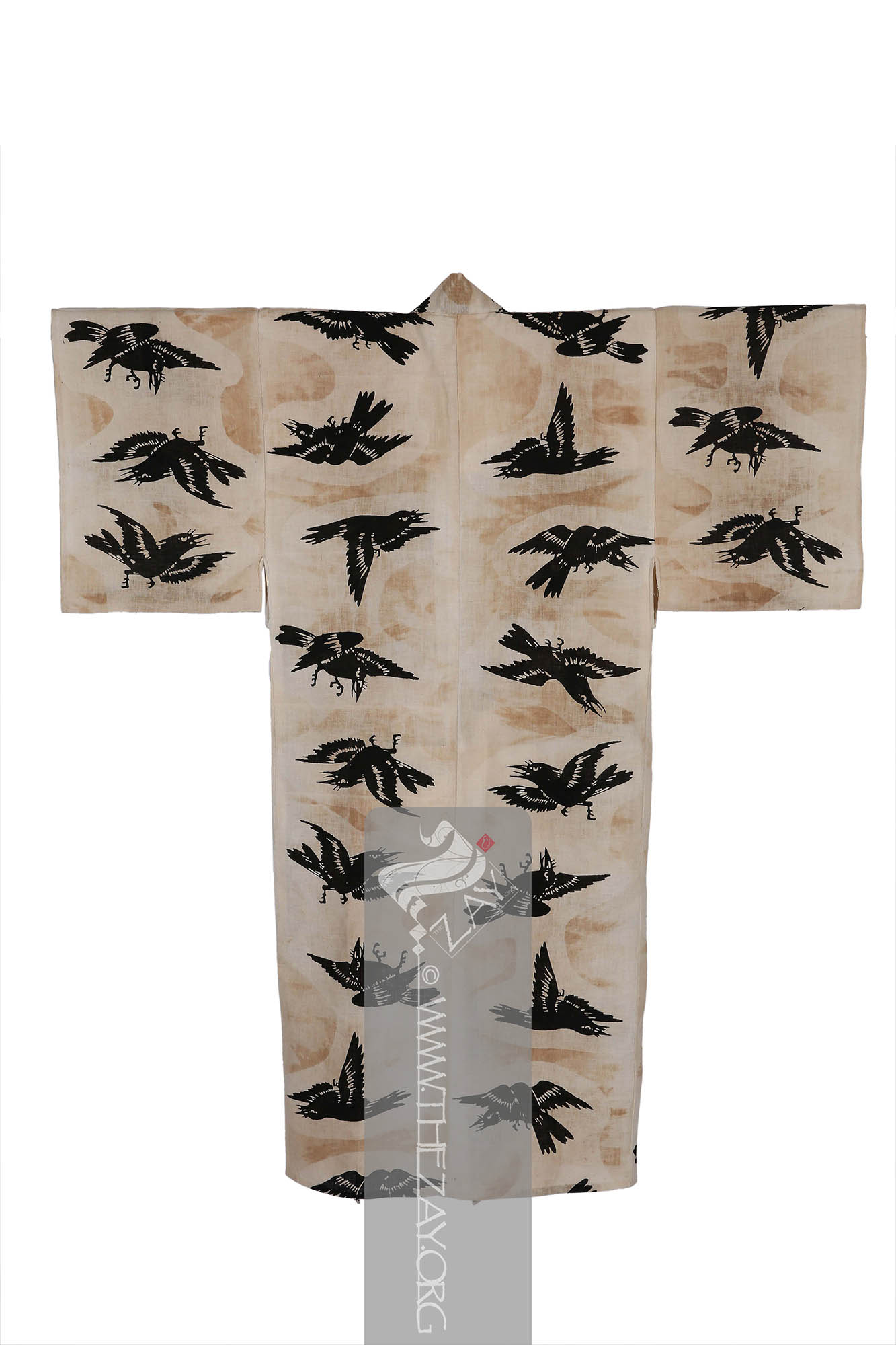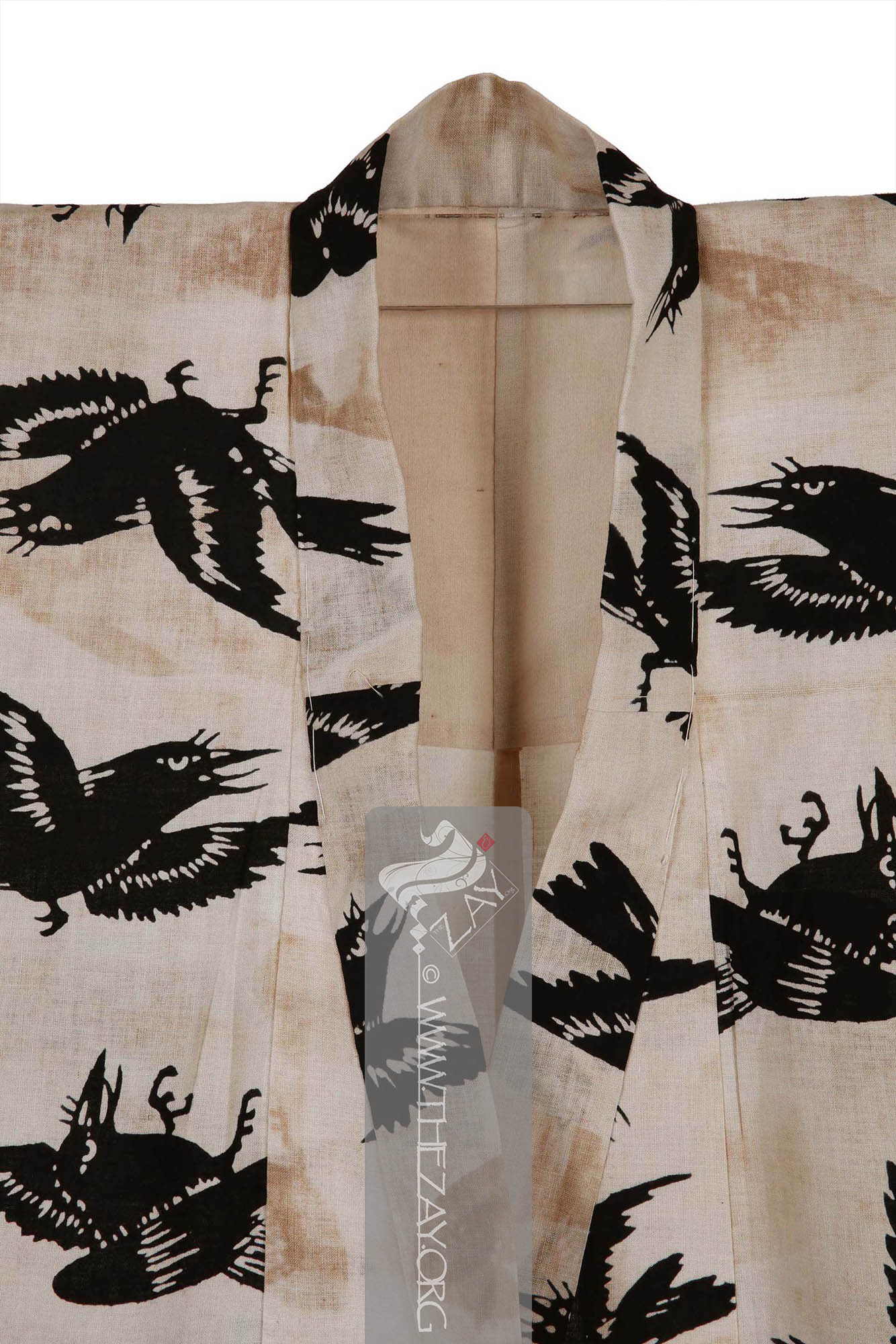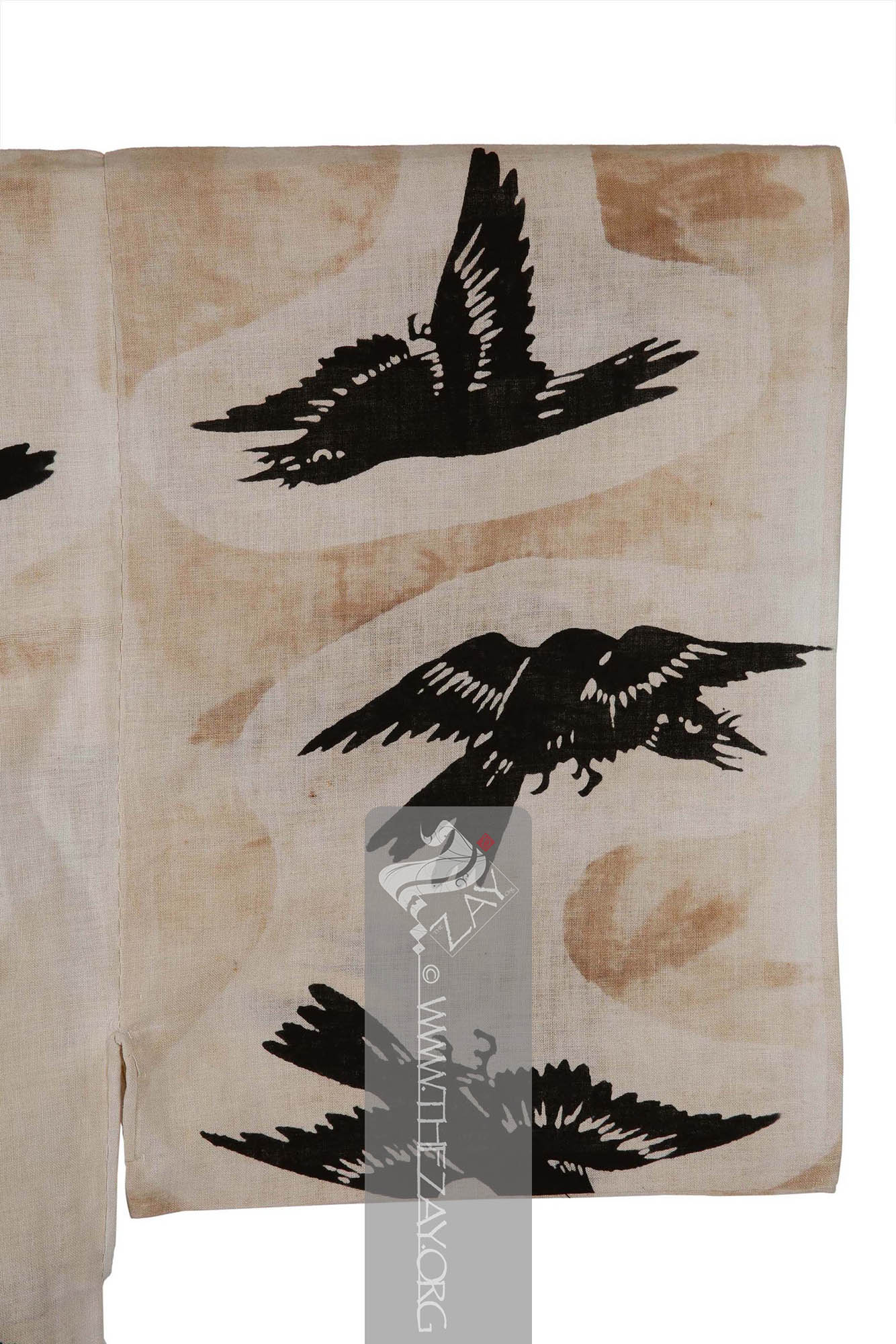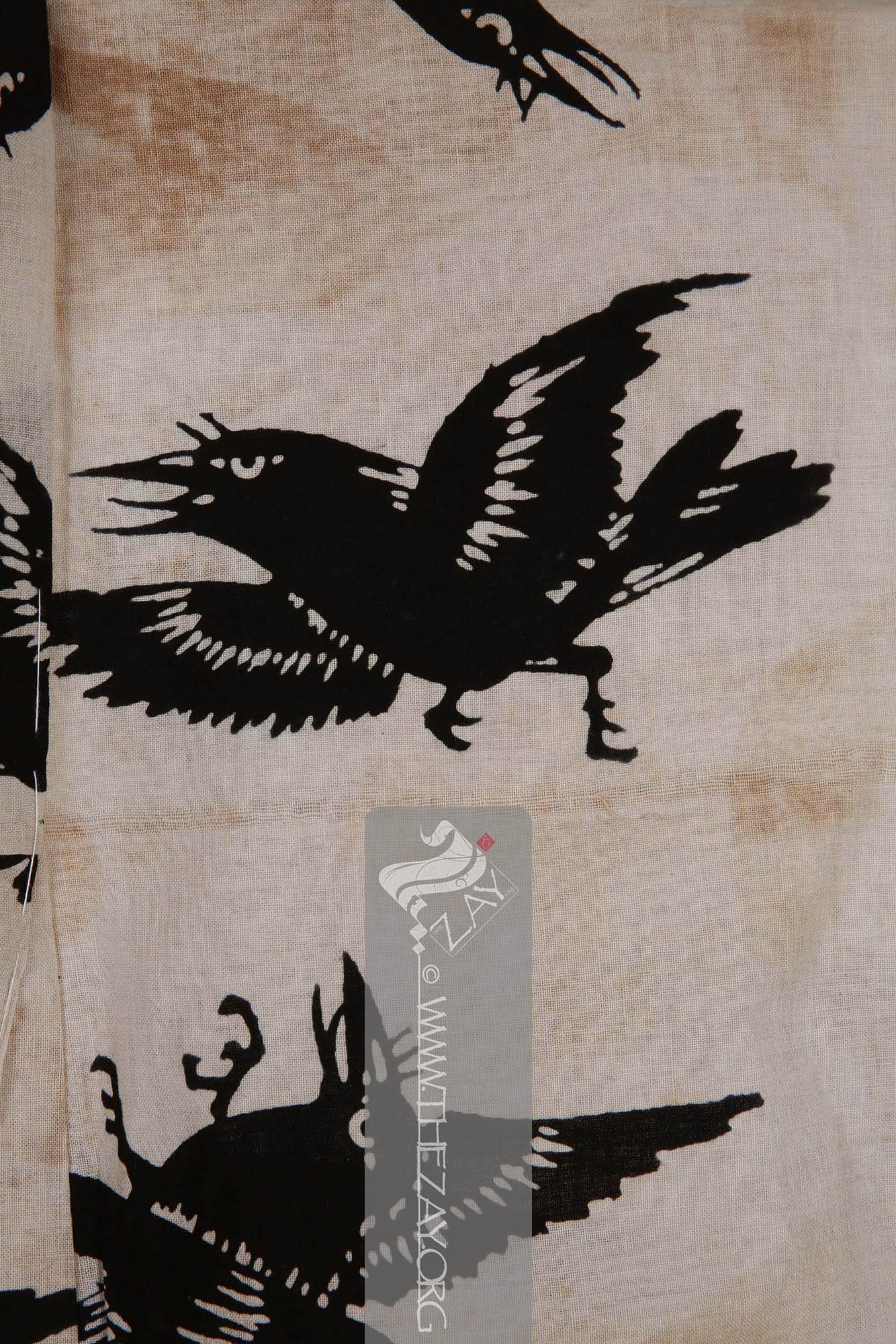Object History This informal men’s (
nagagi_kimono
Nagagi_kimono: (Japanese), a type of traditional Japanese kimono for men often made of either silk, cotton or hemp and is usually coupled with just a jacket or haori. It is worn without the traditional Japanese trousers for men and is often referred to as the “Haori clothing” in English. ) was purchased by
Dr. Reem Tariq
Ṭariq: (Arabic; Synonym: tulle_bi_talli; talli; badla; khus_dozi ), series of small metal knots made on a woven net ground as embellishment. The term is commonly used in the Levant Arab region specifically in Lebanon.
El Mutwalli
Dr. Reem Tariq
Ṭariq: (Arabic; Synonym: tulle_bi_talli; talli; badla; khus_dozi ), series of small metal knots made on a woven net ground as embellishment. The term is commonly used in the Levant Arab region specifically in Lebanon.
el Mutwallī: Founder (CEO) of the Zay
Zay: (Arabic: costume, Pl. azyaā’), a set of clothes in a style typical of a particular country or historical period. Initiative, a public figure, speaker and author. An expert curator and consultant in Islamic art and architecture, interior design, historic costume, and UAE heritage. in 2017 from a dealer in Tokyo, Japan to enhance the collection of The
Zay
Zay: (Arabic: costume, Pl. azyaā’), a set of clothes in a style typical of a particular country or historical period. Initiative. It was made by special order around c. 1900 for a festival gathering of a long-established restaurant in Kyoto.
Object Features This is ivory linen or hemp nagagi_kimono
Nagagi_kimono: (Japanese), a type of traditional Japanese kimono for men often made of either silk, cotton or hemp and is usually coupled with just a jacket or haori. It is worn without the traditional Japanese trousers for men and is often referred to as the “Haori clothing” in English. for men with stitched sleeves with short extensions. The piece is embellished with repeated crow motifs in (katazome_print
Katazome_print: A traditional Japanese resist printing technique where a stencil is used to apply a rice paste resist onto fabric before dyeing, creating intricate and precise patterns. First developed as a substitute to expensive and time-consuming woven brocade it became a well-respected fabric art over time. ). The field of this
nagagi_kimono
Nagagi_kimono: (Japanese), a type of traditional Japanese kimono for men often made of either silk, cotton or hemp and is usually coupled with just a jacket or haori. It is worn without the traditional Japanese trousers for men and is often referred to as the “Haori clothing” in English. is embellished with repeats of black crow motifs in mid-flight rendering a charming yet ominous look to it. The symbolic importance of the crow is utmost among all the birds in Japanese culture. It is considered one of the holiest birds and is often associated with guidance, divineness, and gratitude. Thus, it is not surprising that this piece was ordered for a festival gathering.
The lack of lining and the choice of material suggests that it was summer wear. The lining of the piece is limited to the shoulders, upper back below the neck, and the bottom to prevent the
kimono
Kimono: (Japanese: ki : wearing, mono: thing, Singular: Kimono) A traditional Japanese long loose robe with wide sleeves tied with a sash around the waist. Presently it is the national dress of Japan. from getting stained from any bodily discharge during the summer months while sitting down. It is lined with a similar but plain ivory linen or hemp fabric.
As a
nagagi_kimono
Nagagi_kimono: (Japanese), a type of traditional Japanese kimono for men often made of either silk, cotton or hemp and is usually coupled with just a jacket or haori. It is worn without the traditional Japanese trousers for men and is often referred to as the “Haori clothing” in English. , this would be usually worn with a (
haori
Haori: It is a type of traditional Japanese jacket traditionally worn over a kimono by men. It features an open front tied with cords. Often made of silk or wool it can be adorned with various designs and patterns, making it a popular garment for formal occasions. ) or jacket and without trousers for an informal night out.
Although the acquisition notes from the previous owner described the fabric of the
nagagi_kimono
Nagagi_kimono: (Japanese), a type of traditional Japanese kimono for men often made of either silk, cotton or hemp and is usually coupled with just a jacket or haori. It is worn without the traditional Japanese trousers for men and is often referred to as the “Haori clothing” in English. as “thick cotton”, upon close inspection it has been identified as either linen or hemp.
While the origin of certain techniques and methods in textiles like
satin_stitch
Satin_stitch: (Synonym: Damask Stitch), is a type of flat embroidery stitch that creates a satin like smooth and shiny surface by closely spaced stitches, covering an entire area or shape. embroidery can be traced to China, and its spread across the world could be attributed to the Silk Road, other similar techniques and styles are believed to have originated independently in different regions of the world almost simultaneously in human history possibly from necessity and convenience.
Though The
Zay
Zay: (Arabic: costume, Pl. azyaā’), a set of clothes in a style typical of a particular country or historical period. Initiative is concerned mainly with the dress and adornment heritage of the Arab world, it does include in its collection articles from areas outside the region. These tend to be collected to illustrate specific shared elements and influences attesting that the Arab world never existed in a vacuum. It constantly drew, and continues to draw, inspiration and influences from the cultures it comes in contact with be it through trade or geopolitical circumstances, especially those countries within the old silk route.
Therefore, one cannot but draw parallels between many techniques used in such garments, such as (
couching
Couching: (Latin: collocare – Place together), in needlework and embroidery couching is a technique in which yarn or other materials are laid across the surface of the ground fabric and fastened in place with small stitches of the same or a different yarn
) and thread knotting techniques (
macrame
Macrame: (French: macramé – A hand-knotted textile from Turkish: makrama – table spread or towel, from Arabic: miqrama – bedspread possibly with knotted hanging fringes resembling dangling grapes or karam in Arabic) A form of textile or fringe made by a knotting cord in geometrical patterns possibly originating in Babylon and Assyria.Macrame
Macrame: (French: macramé – A hand-knotted textile from Turkish: makrama – table spread or towel, from Arabic: miqrama – bedspread possibly with knotted hanging fringes resembling dangling grapes or karam in Arabic) A form of textile or fringe made by a knotting cord in geometrical patterns possibly originating in Babylon and Assyria.: makrəˌmā: (Arabic: karam: tree with dangling grapes), ornamental fringe. The art of knotting cord or string in patterns to make decorative articles. Earliest recorded uses of macramé-style knots as decoration appeared in Babylonian and Assyrian carvings.), or flat metal adornment (
talli
Tallī: (Turkish: tel – wire, string), Gulf Arab – a woven braided trimming made with metal wire, threads and ribbons often sewn on detachable panels used as embellishments. Other – (Synonym: tulle_bi_talli
Tūlle_bi_tallī: (French: Tulle – a city in France where fine material for veil was first made; Turkish: tel – wire; Synonym: tariq; talli; badla; khus_dozi
Khus_dozi: (Persian: Khvosh – an Iranian province; dozi – needlework; Synonym: tariq; talli; tulle_bi_talli; badla), series of small metal knots made on a woven net ground as embellishment. The term is commonly used in Iran and parts of the Arabian Peninsula possibly because Khvosh was one of the centres for the craft.
), series of small metal knots made on a woven net ground as embellishment. The term is commonly used in the North African Arab region specifically in Egypt.
; tariq; badla; khus_dozi
Khus_dozi: (Persian: Khvosh – an Iranian province; dozi – needlework; Synonym: tariq; talli; tulle_bi_talli; badla), series of small metal knots made on a woven net ground as embellishment. The term is commonly used in Iran and parts of the Arabian Peninsula possibly because Khvosh was one of the centres for the craft.
), series of small metal knots made on a woven net ground as embellishment.
), that are quite similar to those found in different parts of the Arab region.
The
kimono
Kimono: (Japanese: ki : wearing, mono: thing, Singular: Kimono) A traditional Japanese long loose robe with wide sleeves tied with a sash around the waist. Presently it is the national dress of Japan. , in particular, displays similarities that can be drawn with the pattern of Arab women’s overgarment or the (
thawb
Thawb: (Arabic: thawb, Pl. Athwāb/thībān), can be pronounced thobe
Thobe: (Arabic: thawb, Pl. Athwāb/thībān), can be pronounced thawb or tobe
Tobe: (Arabic: thawb, Pl. Athwāb/thībān), can be pronounced thawb or thobe based on locale. The standard Arabic word for ‘fabric’ or ‘garment’. It can refer to a qamīs-like tunic worn by men and women in the Arabian Peninsula, Iraq, the southern and south-western ports and islands of Iran, and some countries in East and West Africa. More specifically, it can refer to the square-shaped Bedouin overgarment worn by women. based on locale. The standard Arabic word for ‘fabric’ or ‘garment’. It can also refer to a qamīs-like tunic worn by men and women in the Arabian Peninsula, Iraq, the southern and south-western ports and islands of Iran, and some countries in East and West Africa. More specifically, it can refer to the square-shaped Bedouin overgarment worn by women. or tobe
Tobe: (Arabic: thawb, Pl. Athwāb/thībān), can be pronounced thawb or thobe based on locale. The standard Arabic word for ‘fabric’ or ‘garment’. It can refer to a qamīs-like tunic worn by men and women in the Arabian Peninsula, Iraq, the southern and south-western ports and islands of Iran, and some countries in East and West Africa. More specifically, it can refer to the square-shaped Bedouin overgarment worn by women. based on locale. The standard Arabic word for ‘fabric’ or ‘garment’. It can also refer to a qamīs-like tunic worn by men and women in the Arabian Peninsula, Iraq, the southern and south-western ports and islands of Iran, and some countries in East and West Africa. More specifically, it can refer to the square-shaped Bedouin overgarment worn by women in the Arabian Gulf region. ), common to the Gulf region, constructed of three uncut panels of broad clothes forming the central body panel and the side sleeve panels very similar in shape to the
kimono
Kimono: (Japanese: ki : wearing, mono: thing, Singular: Kimono) A traditional Japanese long loose robe with wide sleeves tied with a sash around the waist. Presently it is the national dress of Japan. .
Links
- Morishima, Yuki, et al. Kimono
Kimono: (Japanese: ki : wearing, mono: thing, Singular: Kimono) A traditional Japanese long loose robe with wide sleeves tied with a sash around the waist. Presently it is the national dress of Japan. Refashioned: Japan’s Impact on International Fashion. USA, Asian Art Museum, 2018.
- Kahlenberg, Mary Hunt. Asian Costumes and Textiles: From the Bosphorus to Fujiama. Italy, Skira, 2001.
- Liddell, Jill. The Story of the Kimono
Kimono: (Japanese: ki : wearing, mono: thing, Singular: Kimono) A traditional Japanese long loose robe with wide sleeves tied with a sash around the waist. Presently it is the national dress of Japan. . USA, E P Dutton, 1989.
- Dalby, Liza Crihfield. Kimono
Kimono: (Japanese: ki : wearing, mono: thing, Singular: Kimono) A traditional Japanese long loose robe with wide sleeves tied with a sash around the waist. Presently it is the national dress of Japan. : Fashioning Culture. Reaktion Books, 1993.
- Gluckman, Dale Carolyn and Sharon Sadako Takeda. When Art Became Fashion: Kosode
Kosode: (Japanese: small sleeve or opening), a traditional Japanese inner robe for both genders. Similar to a kimono but with a wider body, longer collars, and narrower and rounded sleeves, often stitched to the body, these under robes were lavishly decorated and were worn on top from late 16th century. in Edo-Period Japan. Los Angeles County Museum of Art, 1996.
- Kimono
Kimono: (Japanese: ki : wearing, mono: thing, Singular: Kimono) A traditional Japanese long loose robe with wide sleeves tied with a sash around the waist. Presently it is the national dress of Japan. : Kyoto to Catwalk. 27 Aug. – 25 Oct. 2020, V&A South Kensington, London https://www.vam.ac.uk/exhibitions/kimono
Kimono: (Japanese: ki : wearing, mono: thing, Singular: Kimono) A traditional Japanese long loose robe with wide sleeves tied with a sash around the waist. Presently it is the national dress of Japan. -kyoto-to-catwalk
- Gluckman, Dale Carolyn. “Liza Dalby. Kimono
Kimono: (Japanese: ki : wearing, mono: thing, Singular: Kimono) A traditional Japanese long loose robe with wide sleeves tied with a sash around the waist. Presently it is the national dress of Japan. : Fashioning Culture.:Kimono
Kimono: (Japanese: ki : wearing, mono: thing, Singular: Kimono) A traditional Japanese long loose robe with wide sleeves tied with a sash around the waist. Presently it is the national dress of Japan. : Fashioning Culture.” Museum Anthropology, vol. 19, no. 1, Mar. 1995, pp. 79–81. Crossref, https://doi.org/10.1525/mua.1995.19.1.79
- “Meisen Kimono
Kimono: (Japanese: ki : wearing, mono: thing, Singular: Kimono) A traditional Japanese long loose robe with wide sleeves tied with a sash around the waist. Presently it is the national dress of Japan. From HALI 184 - HALI.” HALI, 24 July 2015, hali.com/news/meisen-kimono
Kimono: (Japanese: ki : wearing, mono: thing, Singular: Kimono) A traditional Japanese long loose robe with wide sleeves tied with a sash around the waist. Presently it is the national dress of Japan. .
- Kimono
Kimono: (Japanese: ki : wearing, mono: thing, Singular: Kimono) A traditional Japanese long loose robe with wide sleeves tied with a sash around the waist. Presently it is the national dress of Japan. Style: Edo Traditions to Modern Design: The John C. Weber Collection. USA, Met Publications, www.metmuseum.org/art/metpublications/Kimono_Style
- Richard, Naomi Noble. “Nō Motifs in the Decoration of a Mid-Edo Period Kosode
Kosode: (Japanese: small sleeve or opening), a traditional Japanese inner robe for both genders. Similar to a kimono but with a wider body, longer collars, and narrower and rounded sleeves, often stitched to the body, these under robes were lavishly decorated and were worn on top from late 16th century. .” Metropolitan Museum Journal, vol. 25, 1990, pp. 175–83. JSTOR, https://doi.org/10.2307/1512899. Accessed 10 May 2023.
- Kramer, Elizabeth. “Review of ‘Kimono
Kimono: (Japanese: ki : wearing, mono: thing, Singular: Kimono) A traditional Japanese long loose robe with wide sleeves tied with a sash around the waist. Presently it is the national dress of Japan. : A Modern History.’” Reviews in History, School of Advanced Study, 2015. Crossref, https://doi.org/10.14296/rih/2014/1787.




